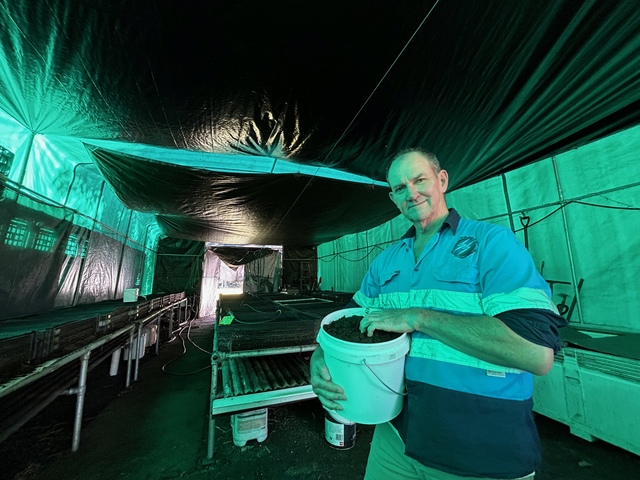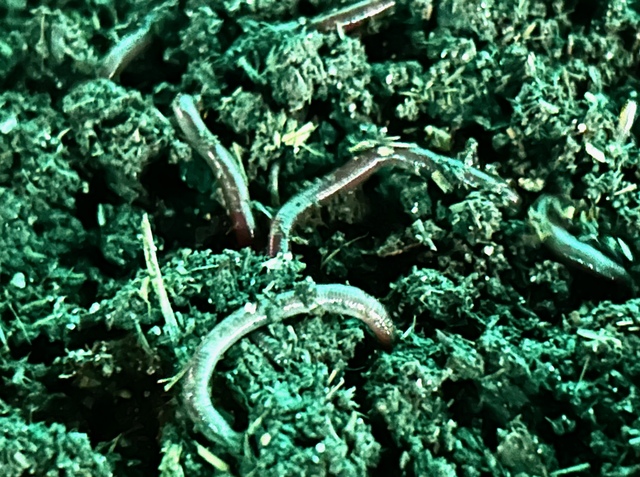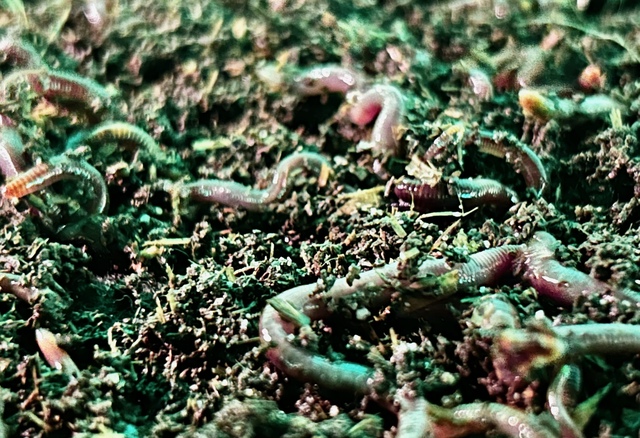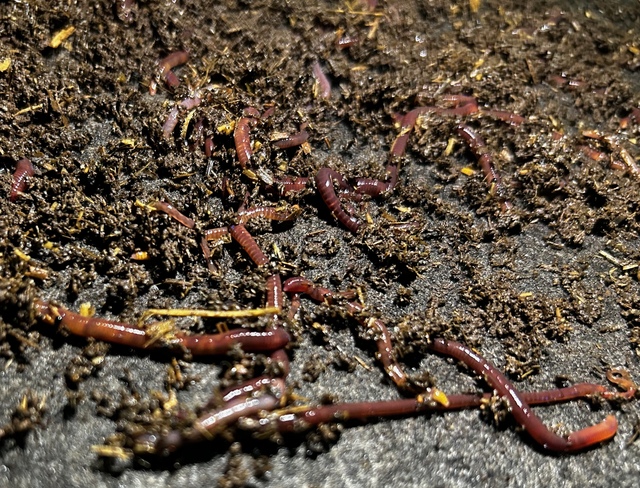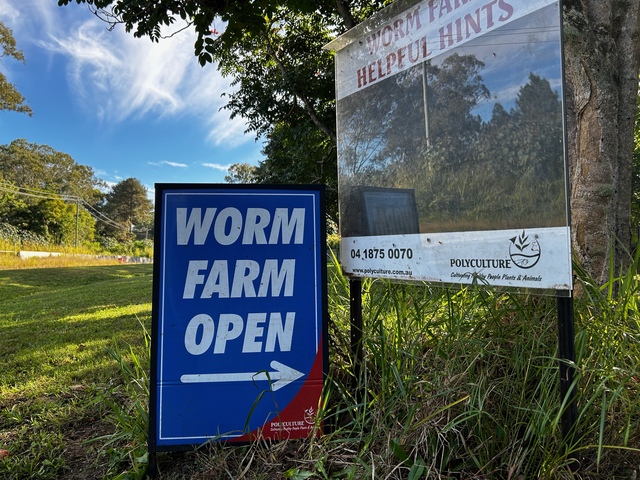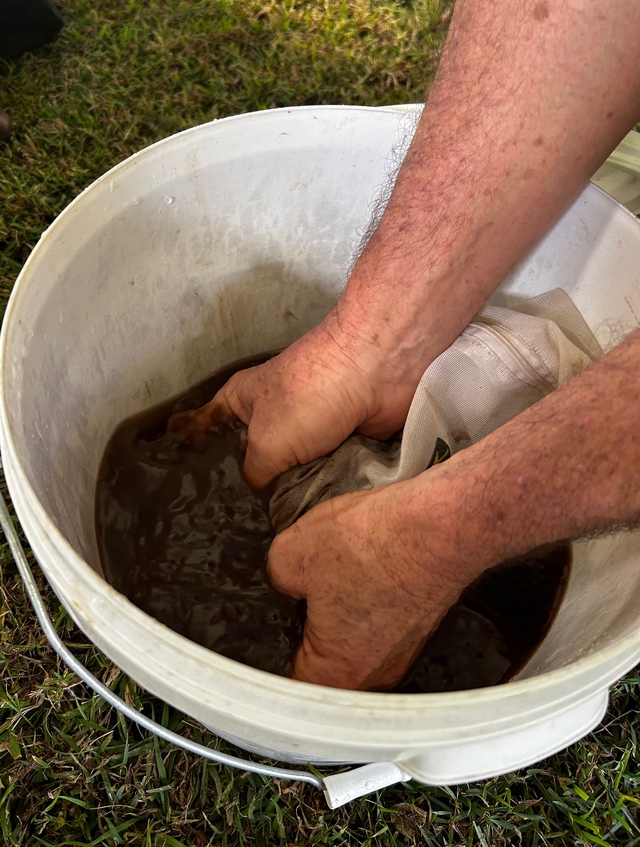PRECEDE
Scott Robinson loves assisting farmers in improving soil health. ERLE LEVEY caught up with him to discuss the difference between soil and dirt, green cover, soil biology and weed management.
BREAKOUT QUOTE
“It’s a matter of stopping the money thing taking over from land health. You can’t keep pumping chemicals into it because you’re entering pest season.”
What is it about worms? Those wriggly, squirmy things that can be found in the garden?
For something so simple there’s a sense of mystery about them – but also a seriousness about the role they play. Children are fascinated by them, yet as adults we are so much in the dark about them; for they are incredibly underrated regarding what they do.
Like bees, like ants, like funghi, they play one of the most significant roles in the health of the planet.
These mysterious invertebrates work continuously to provide a sustainable environment.
Healthy food comes from healthy soil, and that is the right balance of sand, silt, clay and organic matter.
Worm farmer Scott Robinson was at Imbil for GourMay’s Festival Day and his talk about the everyday earthworm was intriguing.
That is why I caught up with him again recently at the Glenview property where he and wife Haidee run Polycultures.
The name comes from two or more useful plants being grown on the same plot, usually at the same time.
From an ecological perspective, they try to mimic natural cycles.
Like natural systems, they offer benefits, including reduced pest damage and soil conservation, even increasing crop yields per area compared to monocultures.
From jackarooing to greenkeeping to cattle farming, Scott is following his passion – assisting farmers in improving soil health.
Earthworms are part of it. So is understanding the difference between soil and dirt, the importance of green cover, soil biology and weed management.
With more than 30 years of self-employment experience, Scott and Haidee have had many opportunities to learn and now guide others to achieve the outcomes they desire on their land.
It’s not just the worms that Scott and Haidee provide but the castings that come from the farm.
“It’s a matter of realising how simple it is to take some worm extract and dilute it with water, then you have got about everything you need for a garden.
“Just make an extract and spray it out there.
“What drains out of the bottom of the worm farm – the castings or compost – we just need to make that extract into a golf ball size and mix it in a bucket of water then spread it with a watering can.’’
Growing up in Brisbane, Scott did work experience as a jackaroo to the north of Longreach.
His mother’s family had land at Bauple and his father was up at Gayndah, where his cousins are still big citrus growers.
“My dad‘s cousin Frankie taught a lot of people how to be a good orchardist – how to manage the trees, how to manage the wildlife, what you can do without using as many chemicals.
“It’s a matter of stopping the money thing taking over from land health. You can’t keep pumping chemicals into it because you’re entering pest season.
“Open grazing is not good for the land, and while horses are beautiful too many people let them open graze. You need to let the area rest and maintain full green ground cover.
“The cycles can continue but if you leave them grazing over the top of it, they will take the youngest plants because they smell the best and pretty soon you won’t have anything left but bare ground.
“At some point you need some sort of seeding plan in there.
“When I was young and with cattle, the only thing I could afford was wild bird mix which was about $8 for a 20kg bag – it had millet and barley and sunflower and some others.’’
Scott’s journey into soil ecology started at a Brisbane boys school, working as a greenkeeper on cricket wickets and sports grounds.
He had the best of both worlds. One teacher was into composting and the other very chemically-orientated.
“About a year into my work at college I got poisoned by chemicals, so for the past 40-odd years I’ve studied everything about soil.’’
That saw him discover that an old arsenic dip on a cattle property had killed all the biology in the soil.
“That was the turning point. I figured I had to do more of this to find out why.
“It’s why I do these presentations for free. I’ve made money in cattle and business; now I’m semi-retired with a commercial worm farm.
“I used to supply a lot of biological extract to farmers but then realised if I show them how to do it on the farm, they can make it more economically.
“I sell them worm castings now. I do courses for students because they need biology as part of their education.
“Simply make an extract from the castings. That’s where the nutrients are. It’s everything they need.’’
Scott’s working on a shipment of worms as we talk at the Glenview farm.
The tunnel measures about 200sq m and here, in the half-light, there are about two million worms breeding – working their way up through three layers of camel manure and compost to create castings.
“We sell worms but castings is the biggest seller. We sell it by the litre as it’s quite moist.
“There’s a 10-litre bucket that will generally take 1000 worms.
“It’s not just for garden beds. By turning the castings into juice, tea or leachgate, as it is called, farmers can spray it over pastures. We have clients with properties of more than 200,000ha.
“For an orchard, you work out how many square metres to a tree. That’s the area below the branches.
“I tried to keep this process as simple as possible, that way anybody can manage what they’ve got whether it’s 100sq m backyard or 100ha … they can adjust what they need to do.
“They can be self-sufficient in 12 months.
“Good health starts with good soil, and good soil starts with worms.’’
What do people need for their own worm farm?
The worm beds can be made of things you can buy at a hardware store. Then create a mulch pile with composting bays for big chunky kitchen scraps but worms prefer the carbons – the sticks and leaves.
You have to maintain moisture – but not too much wet kitchen mulch.
When Scott’s father retired from running a clothing business, he took the role on but also had his polyculture ideas to a point of being able to do consulting.
“That tends to be more just giving good advice on what they need for their land.
“Too many disciplines tell them what they need rather than what soil types they have.
“If you start with a worm farm, compost bins and a mulch heap, well that’s pure gold.’’
Scott and Haidee’s Polyculture business was Landsborough Worms, which Bobby Lewis started and ran for more than 30 years.
He was a chemist at the Nambour sugar mill.
“Bob was a great mentor. I learnt a lot from him but I’ve learnt a lot since and I’ve continued the journey.
“I’ve got to keep that going, especially as there’s a bit more knowledge.’’
At the Glenview farm the worms work their way up through three trays and the castings are harvested from the bottom one.
“We start off with camel manure and a bit of hay. It’s extra organic matter which will have other microbes on it. This gives diversity as it has carbon and nitrogen.
“I don’t have to do anything I can come in here in the middle of summer and it’s like an alien movie – there’s worms everywhere.
“Some times of the year I’ll be harvesting worms every day.’’
As a child I often wondered what happened if you cut them in half while gardening? To this day I still wonder if they divide into two worms or wriggle off and die?
“The two will usually survive,’’ Scott said, “but they’ll never breed again.’’
That brings me to another point, apparently there have been worms in space.
Flatworms have been sent up to the International Space Station to see what the impact is on living creatures. What the scientists have found is when the worms come back they have changed not just their physical shape, but their activity.
For many years Scott had breeder cattle dotted around South-east Queensland.
“I leased properties and probably at any time of the year had close to 600 breeders. They were bloodlines. I tried everything.
“Everything that was trendy through the ’90s, I gave it ago – red devon, murray gray.
“On the coast you are always going to have problems with parasites. If you have only got a monoculture of grass, then you’re always going to have troubles keeping stock in good condition and more resistant to pests such as ticks and flies. You’ve gotta be right on top of it.
“Good soil health, good plant health, good human and animal health come from finding that balance, and the key is to have good moist green cover soil. But you need to maintain that.
“Stable climate starts with moist soil. It’s really that simple which is why so many of us now are promoting hydration. It’s the catalyst for everything – the mineral cycle, the biological cycle.
“The biggest problem with tilling soil is you lose the microbiology in it. If you keep green cover it improves the photosynthesis process.
“Healthy living soil means all of the organisms around a tree keep that tree healthy. And that tree helps keep the other organisms healthy and living.
“It takes that whole community dynamic – fungi included – for everything to survive.
“This regreening is essentially creating a food forest – it’s been going on for thousands of years and people come up with different names and variations.
“They have found food forests that started around the arid areas of North Africa,’’ Scott said. “The Chinese have been doing it for centuries.
“If you don’t have organic matter, you don’t have soil structure which leads to erosion.
“If moisture can be retained in the soil, plants will send out their roots to attract the nutrients, the minerals they require.
“This will impact rainfall and air temperatures – we’ve worked with people at Quilpie and Augathella and they have increased their ground cover and as a result there has been a lift in the amount of rainfall.’’
Instead of tilling and spraying herbicides on thousands of hectares of land, these farmers seed their crop into the soil, Scott said.
“Bare ground costs money as you have no hydration – you have no biology or fertility because hydration is the key to fertility.
“You’re not trying to feed the plants, you’re trying to feed the soil.
“Biological diversity is the key for the micro-organisms to keep your plants healthy. It’s important to keep mulching, keep adding organic matter to your soil.
“The beneficial funghi feeds the plants, maintains the moisture and installs more carbon which builds soil structure.
“If you have the right soil balance, you don’t need to turn the soil over … the plant roots do the work for you.
“It can improve drought and salinity tolerance.’’
Carbon is the building block of life, Scott said, and if the soil is continually opened up it’s mostly the active carbon that is being released.
Passive carbon can last a thousand years in the soil, slow carbon 50 years, but active carbon a few minutes or days.
It’s important not to break the nitrogen cycle because what what we don’t want is nitrous oxide in the atmosphere.
“It’s 300 times more potent in warming the planet than carbon,’’ Scott said.
“There’s more methane produced by fracturing rocks than all of the cows on this planet, and it’s 80 times more potent.
“If we want to reduce the amount of carbon in the air it might take 1000 years to get it back to that balance. It’s really important to understand the balance is the key.’’
Another point to understand is that hydration and irrigation are two different things.
“If we can store more water in the soil then we get better control of the heat dynamic of the plant – if we irrigate we lose 40 percent into the atmosphere.
“Swales are the way to rehydrate and build topsoil. You can do it simply with piling up sticks and branches to slow things down.
“It can make a huge difference.’’
Keyline hydration is the capture of water and using gravitational forces to spread it out into the soil profile.
One percent increase in organic matter per hectare will store water by an extra 200,000 litres, Scott said.
“If you don’t slow the flow, there’s no structure in the soil and temperatures keep getting hotter and hotter every year.’’
Livestock can be used to repair land through planned grazing, Scott said.
Just by moving them around gets the right animals to the right place at the right time for the right reasons.
“When you graze cattle on open land they will go back and smell the protein on the new grass so they will be eating very short grass.
“You need to get the right mix of protein and carbohydrate, which is just before that grass plant goes to seed.
“It’s good for your livestock. It’s good for your structure. It’s about survival of plants.
“If you have grass and livestock you are going to have issues. You have to decide how to move them around.
“What you are looking for is to break the compaction and rebuild those cycles, you need to change the way you manage the land.
“Fence the dam and then build a swale to take the overflow, and distribute the water.
“There’s moisture in the soil, the cattle go in there and eat, trample it and move on.
“Surely but slowly the number of weeds decline because of the way soil is behaving, how the moisture level is maintained.’’
There’s a lot of different disciplines that are under the regenerative farming umbrella, Scott said, and that goes from natural sequence farming to syntropic, to food forests, to permaculture to polycultures.
“They all fit. You just have to show some respect towards each of them … for they all offer something very special and not every property can be managed the same as even the neighbour.
“You have to show some respect for that to realise there’s no one size that fits all. Look at the benefits of the different disciplines.
“It’s about finding the right discipline for that particular piece of land, if you take into account soil types and the topography.
“A lot of land holders fall into the trap of listening and reading too many different things. You have to be very cautious about the advice you take. You can’t do half of part process and expect results.
“It comes about from learning holistic management: make the best decisions we possibly can, set your goals and ensure that your decisions are leading you towards those goals.
“Always go back to check those decisions. Don’t make decisions on your own.’’
For Scott, it’s a matter of passion that drives him on this educational journey for others.
As well as gardeners and farmers, he hosts school groups or visits the schools.
“They can experience what you’re talking about.
“It’s a matter of interaction – a personalisation of skill, experience, and the testing of ideas.
“Taking a bucket of castings and showing them how to make some extract is much better than taking a microscope.
“They are more interested in the complete holistic approach because there is such a huge community online – we get people from overseas wanting to come to Australia and be part of this.
“This is my purpose in life. More people have to get this knowledge.
“I’ve spent 40 years getting this knowledge and I need to keep passing it on.
“Everyone has to find their purpose in life and I’ve found mine.
“Don’t wait as long as I did, find what you really love and learn everything you can about. Find a way to earn a living from it and go about it.
“Retirement is doing less than what you normally do.
“I’ve done quite a few podcasts and it’s a wonderful medium to link with the younger people especially the twenty-somethings. That’s their medium.
“They can’t afford the chemicals now – they can’t keep spraying.
“The thing people have to ask is if it’s an extract … if they extracted the biology from castings then it’s got value.
“It’s the microorganisms that you need to get into your soil and plants to keep them happy and get the best possible yield.
“It’s interesting to watch farmers do it themselves. They get pretty motivated.
“If you’re happy with what you’re doing you realise that’s your purpose and you get on with it because you enjoy it. You find this enjoyment in finding what you’re here for. Use the skill and when the time is right you pass on the knowledge.’’
From wiggly earthworms, to talk of castings, and finally to philosophy, Scott’s life work continues to have a positive impact on soil health and those that directly benefit from it – all of us.

